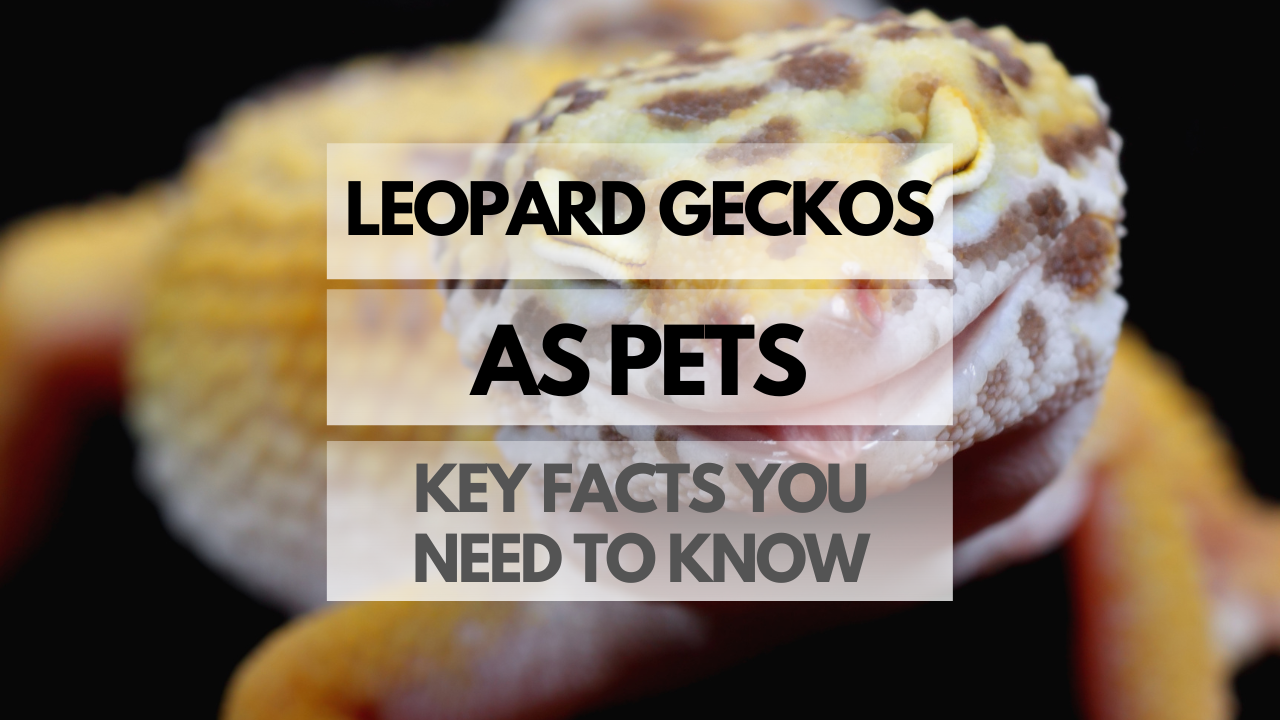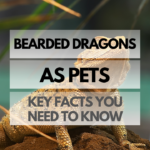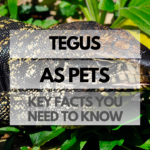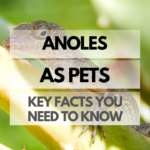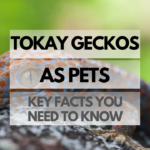Leopard geckos, native to the deserts of Asia and the Middle East, have become increasingly popular as pets due to their easy care, gentle temperament, and unique appearance. This engaging and interesting article will provide you with all the essential information about these fascinating reptiles and help you decide if they’re the right pet for you.
Quick Reference Table: Leopard Geckos Facts
| Fact | Detail |
|---|---|
| Size | 7-10 inches (18-25 cm) |
| Life Expectancy | 10-20 years |
| Temperament | Docile and friendly |
| Level of Care | Easy to moderate |
| Environment | Desert-like, dry and warm |
| Foods | Insects (e.g., crickets, mealworms) |
| Activity | Nocturnal |
How Are Leopard Geckos as Pets?
Leopard geckos make excellent pets for both beginners and experienced reptile enthusiasts. They are low-maintenance, generally friendly, and have a fascinating behavior that makes them enjoyable to watch and interact with.
Pros and Cons of Leopard Geckos
Pros:
- Easy to care for
- Docile and friendly
- Wide variety of colors and patterns
- Long lifespan
Cons:
- Require specialized habitat setup
- Need live insects for food
- Nocturnal (active at night)
Leopard Geckos Behavior and Temperament
Leopard geckos are known for their gentle nature and are generally easy to handle. They are not aggressive and rarely bite, making them a great option for families with children. However, they are nocturnal, which means they are most active during the night and may be less interactive during the day.
How Much Do Leopard Geckos Cost?
Leopard geckos themselves typically cost between $20 and $100, depending on their morph and availability. Initial setup costs, including the enclosure and necessary equipment, can range from $100 to $300. Ongoing expenses, such as food and substrate, will also need to be considered.
Leopard Geckos Lifespan: Time and Commitment
Leopard geckos have a life expectancy of 10-20 years, so they are a long-term commitment. Caring for a leopard gecko requires regular maintenance, including feeding, cleaning the habitat, and monitoring temperature and humidity levels.
Leopard Geckos Size
Adult leopard geckos typically measure between 7-10 inches (18-25 cm) in length, with males being slightly larger than females.
Leopard Geckos Species
While there is only one species of leopard gecko, Eublepharis macularius, there are numerous color and pattern morphs available, each with its unique appearance.
Leopard Geckos Colors, Looks and Appearances
Leopard geckos come in a wide range of colors and patterns, including yellow, orange, white, lavender, and even black. Their patterns can vary from the classic leopard spots to stripes, bands, or completely patternless.
Leopard Geckos Care Guide
Providing the proper care for your leopard gecko is essential for their health and happiness. The following sections will guide you through the necessary aspects of leopard gecko care.
Leopard Geckos Habitat: Tank and Housing
Appropriate Leopard Geckos Tank Size
A single leopard gecko requires a minimum 20-gallon tank, while a pair or small group will need a larger space of 30-40 gallons. Make sure to provide a secure lid to prevent escapes.
Types of Enclosures
Glass terrariums are the most popular choice for leopard geckos, as they provide good visibility and are easy to clean. Other options include plastic or PVC enclosures, which can help maintain humidity and temperature more easily.
Substrate Options
Substrate options for leopard geckos include reptile carpet, paper towels, and non-particulate options like tile or slate. Loose substrates, such as sand or wood chips, should be avoided, as they can cause impaction if ingested.
Heating and Lighting Requirements
Leopard geckos require a temperature gradient in their enclosure, with a basking spot around 88-92°F (31-33°C) and a cooler side around 75-80°F (24-27°C). A heat mat or ceramic heat emitter can be used to maintain these temperatures. They do not require UVB lighting, but a low-intensity UVA light can help regulate their day-night cycle.
Humidity and Temperature Control
Maintaining proper humidity levels is important for leopard geckos, as it aids in shedding. Aim for a humidity level of 30-40%. Provide a humid hide filled with moist sphagnum moss or paper towels to help with shedding.
Furnishings and Decorations
Leopard geckos need a minimum of two hides, one on the warm side and one on the cool side. Additional decorations, such as branches, rocks, and artificial plants, can provide enrichment and opportunities for climbing.
Cleaning and Maintenance
Spot-clean the enclosure daily by removing any visible waste and uneaten food. Replace the substrate as needed, and clean the entire enclosure with a reptile-safe disinfectant every 4-6 weeks.
Leopard Geckos Food: Diet and Nutrition
Feeding Frequency and Schedule
Leopard geckos are insectivores and should be fed every other day for adults and daily for juveniles. Feed them a variety of insects, such as crickets, mealworms, and waxworms, but avoid feeding them exclusively one type of insect.
What do Leopard Geckos Eat?
Leopard geckos eat a diet primarily of insects, including crickets, mealworms, waxworms, and occasionally small roaches. They do not eat plants, fruits, or vegetables.
Leopard Geckos Treats
Treats for leopard geckos can include waxworms, hornworms, or butterworms, but these should be fed sparingly due to their high-fat content.
Foods to Avoid
Avoid feeding leopard geckos insects caught in the wild, as they may carry parasites or be contaminated with pesticides. Never feed them insects that are too large, as this can lead to choking or impaction.
Supplements and Vitamins
Dust insects with a calcium supplement before feeding, and provide a separate dish of calcium powder in the enclosure. Additionally, dust insects with a multivitamin supplement once or twice a week to ensure proper nutrition.
Hydration
Provide a shallow water dish for your leopard gecko to drink from, and clean and refill it daily. The water dish also helps maintain humidity in the enclosure.
Handling and Socialization
Taming and Bonding
Leopard Geckos are generally docile and easy to tame with a little bit of patience and consistent handling. Start by placing your hand in their enclosure and allowing them to become familiar with your presence. Gradually, you can begin to pick them up gently and hold them for short periods, increasing the duration over time. This process helps to create a bond of trust between you and your Leopard Gecko.
Safe Handling Techniques
Always handle your Leopard Gecko with care and respect. Scoop them up gently from underneath, supporting their body and legs to prevent injury. Avoid grabbing or squeezing them, as this can cause stress and potential harm. When holding them, allow them to crawl on your hands and explore, but keep them close to a surface to prevent falls.
Signs of Stress and Illness
Pay attention to your Leopard Gecko’s behavior and appearance to identify signs of stress or illness. These can include lethargy, loss of appetite, irregular shedding, or changes in their fecal matter. If you notice any of these signs, consult with a reptile veterinarian for guidance.
Introducing Leopard Geckos to Other Pets
When introducing your Leopard Gecko to other pets, approach with caution and closely monitor their interactions. Remember that not all pets will get along, and some may pose a threat to your Leopard Gecko’s safety. Always prioritize the well-being of your pets and separate them if necessary.
Health and Wellness
Common Health Issues
Leopard Geckos can experience several health issues, such as metabolic bone disease, parasites, and respiratory infections. Providing a proper environment, diet, and regular check-ups with a reptile veterinarian can help minimize these risks.
Signs of a Healthy Leopard Gecko
A healthy Leopard Gecko will have bright eyes, a plump tail, and smooth, well-shed skin. They should be active, alert, and have a strong appetite. Regularly monitoring your Leopard Gecko’s health and behavior will help ensure their well-being.
Preventative Care
Maintaining a clean enclosure, offering a balanced diet, and providing appropriate temperature and humidity levels are essential for your Leopard Gecko’s preventative care. Regular check-ups with a reptile veterinarian can help catch any potential health issues early on.
Finding a Reptile Veterinarian
It’s crucial to find a qualified reptile veterinarian for your Leopard Gecko. Seek recommendations from fellow reptile enthusiasts, online forums, or local pet stores. Remember that not all veterinarians have experience with reptiles, so ensure that your chosen vet has the necessary expertise.
Breeding and Reproduction
Determining Gender
To determine the gender of your Leopard Gecko, look at the underside of their tail base. Males have a V-shaped row of pre-anal pores and two hemipenal bulges, while females have a more subtle row of pores and lack the bulges.
Mating Behavior and Courtship
Mating behavior in Leopard Geckos can include the male chasing and nudging the female, followed by biting her neck and mating. Courtship can sometimes appear aggressive, so monitor the interaction closely to ensure the safety of both geckos.
Gravidity and Egg-laying
A gravid female Leopard Gecko will develop a noticeable swelling in her abdomen as she carries her eggs. She will lay her eggs in a moist, secluded area of the enclosure. Provide a suitable egg-laying site, such as a container filled with damp sphagnum moss or vermiculite.
Incubation and Hatching
Incubate Leopard Gecko eggs in a separate container with a temperature between 80-90°F (26-32°C). The temperature will determine the sex of the hatchlings, with higher temperatures producing more males. Eggs typically hatch after 30-60 days of incubation.
Caring for Hatchlings
Provide hatchling Leopard Geckos with a smaller enclosure, proper heat and humidity, and a diet of appropriately-sized insects. Monitor their growth and development closely, and consult with a reptile veterinarian for guidance on their care.
Are Leopard Geckos Legal?
Leopard Geckos are legal in most countries and states, but it’s essential to check your local laws and regulations before acquiring one as a pet. Some areas may require permits or have specific restrictions in place.
Popular Names for Leopard Geckos
Choosing a fun and interesting name for your Leopard Gecko can be an exciting part of pet ownership. Some popular names include:
- Geico
- Leo
- Spot
- Stella
- Echo
- Zeus
- Luna
- Rex
- Pixel
- Rocky
Conclusion: Should You Own Leopard Geckos as Pets?
Leopard Geckos can be wonderful pets for responsible owners who are willing to provide proper care and a suitable environment. They are generally docile, easy to handle, and have captivating personalities. Remember that owning a Leopard Gecko is a long-term commitment, and their health and happiness rely on your dedication and attention. With the right care, understanding, and love, a Leopard Gecko can be a rewarding and enriching addition to your life.
FAQ for Pet Leopard Geckos
- Q: Are Leopard Geckos good pets?
- A: Yes, Leopard Geckos make great pets for those willing to provide proper care and a suitable environment. They are generally docile, easy to handle, and have captivating personalities.
- Q: Can Leopard Geckos eat grapes, bananas, strawberries, apples, spinach, tomatoes, carrots, cucumbers, watermelon, broccoli, blueberries, celery, cabbage, cilantro, kale, blackberries, oranges, avocados, corn, or asparagus?
- A: No, Leopard Geckos are insectivorous and should not be fed fruits or vegetables. Their diet should consist primarily of insects, such as crickets, mealworms, and dubia roaches.
- Q: How often do Leopard Geckos eat?
- A: Leopard Geckos should be fed daily when they are young and 3-4 times a week as they grow older. Adjust the feeding frequency based on your gecko’s age, size, and activity level.
- Q: How long do Leopard Geckos live?
- A: With proper care, Leopard Geckos can live for 15-20 years or more in captivity.
- Q: Where are Leopard Geckos native?
- A: Leopard Geckos are native to the arid regions of Afghanistan, Iran, Iraq, and Pakistan.
- Q: Are Leopard Geckos friendly?
- A: Yes, Leopard Geckos are generally docile and friendly, making them suitable pets for handling and interaction.
- Q: Do Leopard Geckos bite?
- A: While Leopard Geckos can bite, they rarely do so unless they feel threatened or stressed. Proper handling and socialization minimize the chances of a bite.
- Q: Do Leopard Geckos like to be held?
- A: Leopard Geckos can become accustomed to handling and may enjoy exploring their owner’s hands, but always handle them gently and with respect for their comfort level.
- Q: Are Leopard Geckos nocturnal?
- A: Yes, Leopard Geckos are nocturnal, meaning they are most active during the night and sleep during the day.
- Q: Do Leopard Geckos pee?
- A: Leopard Geckos excrete urates, a semi-solid form of waste, alongside their feces. This allows them to conserve water in their natural arid habitat.
- Q: Do Leopard Geckos hibernate?
- A: Leopard Geckos do not hibernate but may experience a period of brumation, a state of reduced activity and metabolism, during colder months. This is not necessary for captive geckos, as their environment should be maintained at consistent temperatures.
- Q: Do Leopard Geckos make noise?
- A: Leopard Geckos can make a variety of noises, such as chirping, squeaking, or growling, but they are generally quiet pets.
- Q: Are Leopard Geckos venomous or poisonous?
- A: No, Leopard Geckos are neither venomous nor poisonous.
- Q: Are Leopard Geckos smart?
- A: While they may not be considered highly intelligent compared to some animals, Leopard Geckos can recognize their owners, learn routines, and display unique personalities.
- Q: Do Leopard Geckos need heat at night?
- A: Yes, Leopard Geckos require a heat source at night to maintain a proper temperature gradient in their enclosure. A ceramic heat emitter or under-tank heater can be used to provide nighttime heat.
- Q: Do Leopard Geckos lay eggs?
- A: Yes, Leopard Geckos are oviparous, meaning they lay eggs. Female geckos will lay eggs in moist, secluded areas of their enclosure.
- Q: Do Leopard Geckos smell?
- A: Leopard Geckos themselves do not have a strong odor. However, a poorly maintained enclosure can develop unpleasant smells. Regular cleaning and proper husbandry will keep odors to a minimum.

